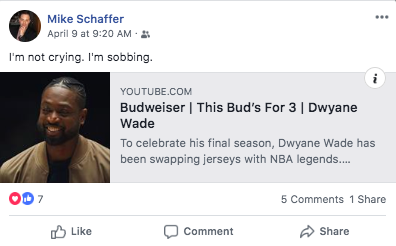By now (especially if you’re a basketball fan), you’ve seen the Dwyane Wade video Budweiser produced.
It has been shared everywhere over the last few days–timing up with Wade’s retirement from the NBA. And, it’s eliciting all the feels from fans and non-fans.

It’s an impressive idea and piece of social content from Budweiser, no doubt. But, the interesting wrinkle here to me is that the entire video has really very little to do with beer or selling beer. In fact, you don’t see a single Bud mention or logo until 3:55 of a 3:58-long video (although, smartly Bud does include a scoreboard graphic in the background of a few shots).
No, this is a decidedly unbranded piece of content.
And sure, it’s been done before. Many times.
But, at the same time, I continue to hear and see people ramming corporate messages into content ideas that simply don’t need it.
There’s a lot to be said for subtlety, folks.
And, telling a story–an emotional story.
That’s exactly what Bud did here. And brilliantly, I might add.
Instead of re-hashing what Bud did with this video, I’d like to talk more about the learnings for other brands–because I think that’s a big piece of this.
I see a few things most of us can take away here:
1: Resist the urge to over-promote
It’s hard. I know. I’ve been there. But, it’s our jobs to push back on our corporate leader partners. It’s our job to say, “maybe we don’t need another corporate message here.” It’s our job to focus on the storytelling, not necessarily always working the brand into every conversation. This is what resisting the urge to over-promote looks like on a daily basis. That’s what Bud did here.
2: Think sponsorship instead of promotion
Every time I see one of these great, emotional, compelling pieces of content, they almost seem like they’re sponsored content. Like someone else created them and the brand just slapped their name on it very subtlely. That’s what the Bud video feels like. It feels like they sponsored someone else’s content vs. creating a PROMOTIONAL piece of content featuring DWade. That’s the difference. And, it has everything to do with how the content is created. If you’re merely sponsoring the content, the editorial team can go to work in creating a story free of corporate interferences. If you’re sponsoring content, there’s probably not that marketer in the room saying we have to work the logo into shoot more. If you’re sponsoring content, you’re free to explore ideas that probably get shot down by corporate leadership far earlier. Think sponsoring vs. promoting. It may change your entire outlook.
3: Sharing is directly tied to emotions
It’s 2019 and yet clients still want content to “go viral.” Amirite? And, you’re right, there’s no magic way to make that happen. But, if you’ll notice, the brand content that actually does get shared–like this Bud video–it almost always tied to emotions. So, isn’t the key to think about the stories and potential stories you could uncover (or create) that tie to emotions like sadness and joy? I know this is kinda stating the obvious, but I also know so many companies HAVE these stories yet fail to tell them in a way that isn’t completely over-promotional? Storytelling is an art form. And, even a great emotional story can get bogged down by corporate messaging. So, get out of the damn way! Let the story stand on its own. If you do it right, it will get those shares. Budweiser knows that. Which is why the DWade video has already been viewed 2.3 million times.

0 Comments